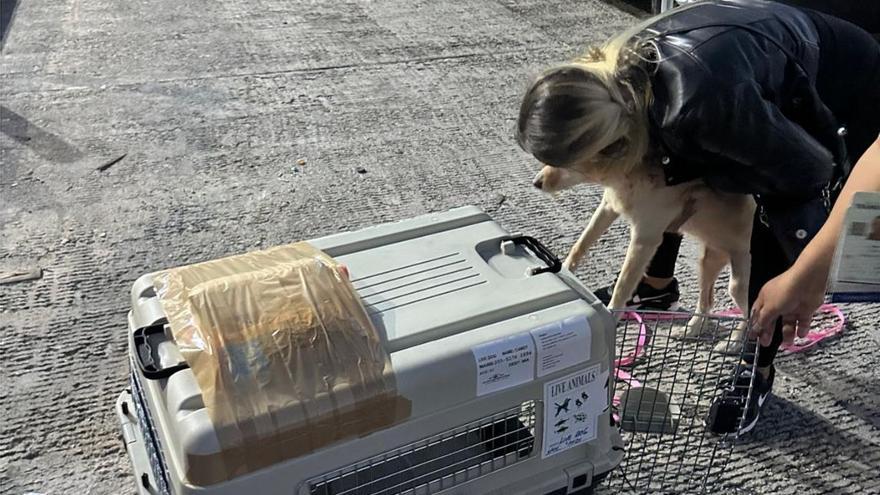
![]() 14ymedio, Havana, 6 February 2024 — From Santa Clara to Havana, from Havana to Cancun, from Cancun to Miami. The trip of Brandy, a five-year-old Creole dog, was not very different from the one its owners made twelve months ago. But the reunion had a price: tensions, bribes to process the documentation and $3,000 in expenses.
14ymedio, Havana, 6 February 2024 — From Santa Clara to Havana, from Havana to Cancun, from Cancun to Miami. The trip of Brandy, a five-year-old Creole dog, was not very different from the one its owners made twelve months ago. But the reunion had a price: tensions, bribes to process the documentation and $3,000 in expenses.
“We left Brandy in Cuba with some friends, and I promised them that it would not take me more than a few months to bring her to the United States. It ended up being a year, but now she’s here with me,” Lorena, a 52-year-old from Santa Clara, tells this newspaper. “We became very fond of her after taking her off the street, and although people think I’m crazy to spend so much money on a pet, I decided to bring her to Miami,” she says.
There are many people who perform this service and charge between 2,100 and 2,800 dollars, depending on the size of the animal and the price of the plane tickets
The procedures were quite cumbersome, says the Cuban. “While I was saving, I was investigating ways to bring the dog. I discovered that there are many people who perform that service and charge between 2,100 and 2,800 dollars depending on the size of the animal and the price of the plane tickets at the time,” explains Lorena. At almost 30 pounds, Brandy is considered medium weight.
By the “legal” way, she resumes, the United States requests the internal and external deworming of the pet and several vaccines, including rabies, which must be given. Then you have to wait a month and take blood from the animal, centrifuge it and send it frozen to a laboratory in Kansas, which is the only one capable of doing that type of analysis. Then you must wait a few months for the institution to respond and only then, with the vaccination card ready, can pets travel to the United States.
“These requirements are from the CDC (Center for Disease Control) in the United States, which lists Cuba among the countries at high risk for canine rabies. Cubans, however, have already found ways to circumvent those controls,” says Lorena.
The first trick, she continues, “is to send the pet to a third country. Mexico, because of its proximity and how easy it is to then send the animals to the United States, has been the perfect stopover. The Mexican authorities don’t know the origin of the pets or whether the veterinarians in charge of examining them have been paid to falsify the vaccination certificates. This procedure has become a business that all Cubans use, which circumvents the several months of waiting imposed by the lab in Kansas.” For Brandy, she says, they even put on vaccine labels dated 2020. “They have everything ready, you just have to pay.”
“The total amount I paid for the trip, including the papers, was $2,600, since Brandy is a medium-sized dog and had to travel in the hold of the plane. For a small dog, which can sit with its owner, the cost is $2,500. That price also includes the ticket of the person who took her to Mexico, which I had to pay here by Zelle. For the rest of the money, they came to get it in Miami at my house,” Lorena explains.
Once Brandy got to the airport she was put on the plane in a crate and sent to Cancun with the Viva Aerobus airline
Lorena had to add the purchase in Miami of a crate to transport Brandy and its shipment to Cuba through the parcel agencies. She also purchased a leash and other accessories and paid for Brandy’s trip to Havana in the company of its temporary caregivers. “All that came out to about 550 dollars, because I sent some extra for them to eat something on the trip to the airport. The car cost 40,000 Cuban pesos, and the snacks, ham at 400 and a soft drink at 150,” she says.
Once Brandy arrived at the airport, she was put on the plane in a crate and sent to Cancun with the Viva Aerobus airline. “Not all companies allow you to travel with pets,” says Lorena.
After a night in Mexico, Brandy boarded a second flight to Miami through the cargo airline Estafeta. An hour later, her owner picked her up at one of the warehouses at the Fort Lauderdale airport. “All the airport workers stopped to see me take Brandy out of the crate and how happy she was to see me. It was an exciting moment and made me think about how much animals are loved in the world, unlike in Cuba, where some went so far as to suggest that I kill the dog, and others abandon their pets on the street as soon as they can leave the country. It’s a shame that even Cuban dogs have to arrive illegally in the United States,” Lorena laments. “In that they’re like us.”
Translated by Regina Anavy
____________
COLLABORATE WITH OUR WORK: The 14ymedio team is committed to practicing serious journalism that reflects Cuba’s reality in all its depth. Thank you for joining us on this long journey. We invite you to continue supporting us by becoming a member of 14ymedio now. Together we can continue transforming journalism in Cuba.
